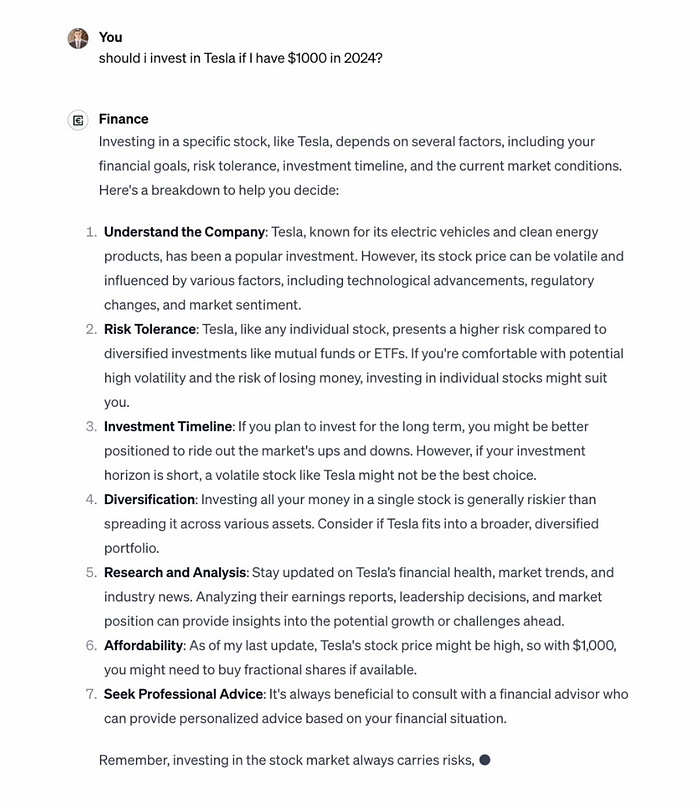GPT Store is a UX disaster
OpenAI recently released a long-awaited store for GPTs. Now, ChatGPT Plus subscribers can access a collection of GPTs created by different users. In this article, I want to review the downsides of the current version of the store.
This review is also available in a video format:
GPTs home page
When we navigate to the Explore GPTs section, we will see a page that invites us to discover GPTs that suit our needs. We see a search bar and some categories such as Top Picks, Dall-e, Writing, Productivity.
The first problem that we face is category selection. It’s unclear why Dall-e, Writing, Productivity, Research & Analysis are selected as the top-level categories. There are no categories like Finance, Travel, or Health. Below are the categories from AppStore, and you can see that the list of categories is more relevant to everyday activities.
The naming of categories at the GPT Store is a bit confusing, too. The category “Dall-e” is basically image generation, but it has the name of the tool rather than the action that the user wants to perform using it.
If you look closely at the actual GPTs, you will notice another problem. You will need to read the text to understand what the GPT does for you. Apart from GPT icons, OpenAI doesn’t offer any visuals. And icons are not always self-explanatory. But reading the text is not the most enjoyable experience. It will require a lot of brainpower right from the start.
Searching a specific GPT
If we have a particular goal on our mind that we want to accomplish, for example, we want to find a finance advisor for ourselves, we will face another problem. Once you start typing your query, you will see that OpenAI offers recommendations based on the keywords you provided rather than analyzing your intention.
What I mean by that is when I say finance advisor, I want to see a list of finance apps. Tech Support Advisor or Jo Ellen Mathews results look irrelevant to my goal.
Apart from the GPT name, OpenAI doesn’t offer any information on what the GPT provided in the list is doing. So, I assume I need to spend time to figure out what the app does. At least for me, it usually leads to a lot of time invested in testing various GPTs before I find the one that I need.
There is another problem. It’s hard to figure out what other users think about the app. Take a look at the Apple AppStore for Yahoo Finance.
Apart from the visuals that communicate the purpose of the app, you see the rating, and you can read not only about the app itself but also what actual users think about it. And identify both the positive and negative sides of the product.
OpenAI doesn’t offer that. So, there is no way to rely on other people’s options when evaluating the GPT.
Using a custom GPT
Let’s try the first GPT from the search results (I assume it’s the one that OpenAI thinks is the most relevant to my goal) and see how it will help us solve our problem.
Suppose I have 1000 dollars that I want to invest in stock, and I wonder if I should buy Tesla stock in 2024. Finance GPT provided a relatively long response, but it didn’t answer my question. Let’s force the GPT to give a precise answer — yes or no.
The GPT failed to do it. It’s true that finance advising is a tricky thing, and there is a legal risk for the tool to say you should or shouldn’t invest in something. But still, my goal is to get financial advice, not a general response about how to invest money.
I’ve tried many custom GPTs and want to say that most of the work is not really well. Many GPTs feel like half-baked apps that were created back in November 2023 when OpenAI announced custom GPTs. So, I think that OpenAI should review current GPTs and remove all mediocre apps from the store.
History of operations
ChatGPT doesn’t show the logo of a specific GPT in History. So, all results look the same to me, both results from native ChatGPT and custom GPTs.
So, as you can see here, Finance GPT has its own logo, but the result doesn’t feature it.
Marketing and GPT discoverability
Marketing is an integral part of mobile stores like AppStore or Google Play, and both marketplaces offer a way to promote your mobile app.
But right now, I don’t see any marketing tools in the GPT store. Consider that many people will try to create their GPS in the coming weeks; without efficient marketing tools baked into the store, there is simply no way to promote your product.
So, even if you have a very useful GPT, you won’t be able to acquire many users.
In conclusion
I know that the GPT store is only making its first steps on the market, and it’s hard to release a perfect from the first attempt. I truly believe that the OpenAI team will do their best to make it perfect.
Originally published at babich.biz














